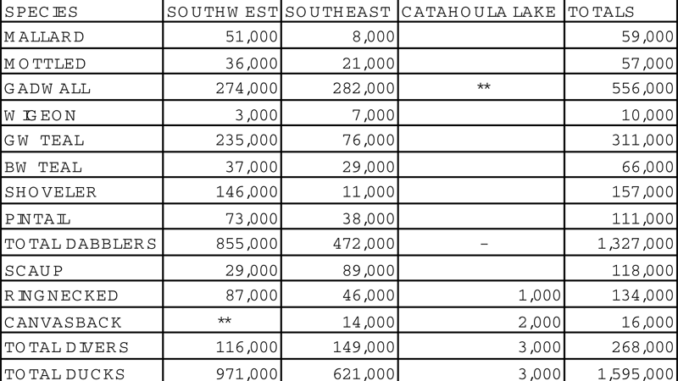
Waterfowl population estimates in Louisiana’s coastal zone below U.S. Highway 90 and on Catahoula Lake
The estimate of 1.6 million ducks on this survey is 66% higher than the November estimate. (The December, 2008 survey was not completed due to mechanical problems and bad weather, so no comparable data are available from last month). However, this January’s estimate is 13% lower than the 1.8 million last year and is the lowest January estimate since this survey began. The last 2 January surveys are among the 4 lowest since 1978, which include estimates of 1.7 million in 1983 and 1987. They are stark contrast to the 4.4 million ducks estimated in 2007 by this same survey crew, and the 1.6 million estimated this year is about half of both the 5-year and long-term averages (3.2 million).
Estimates for all species except gadwalls, scaup and ring-necked ducks declined from January 2008, especially those for mallards (-56%), blue-winged teal (-61%), canvasbacks (-84%), and coots (-55%), while the estimate for mottled ducks remained about the same as in 2008 (57,000 compared to 59,000). The scaup estimate increased from 24,000 in 2008 to 118,000 on the transect lines, and numerous rafts of scaup were seen offshore from the Calcasieu Ship Channel to Rockefeller Refuge. All species were below their long-term January averages.
Although the distribution of ducks counted on coastal transects continues to be skewed toward southwest Louisiana, the 971,000 estimated there is less than the 1.3 million seen in 2008, while the 621,000 estimated in southeast Louisiana is markedly higher than the 419,000 in 2008. Most of that change came from an increase in the number of gadwalls seen in southeast, especially in the Biloxi marsh area, and the big decreases in the number of mallards, gadwalls, and blue-winged teal in southwest Louisiana. Noteworthy from this survey was the large decline in coots in southwest Louisiana from 620,000 in 2008 to 160,000 this year. An extremely low number of ducks were seen on Catahoula Lake compared to 74,000 in November 2008 and 104,000 last January.
An additional 220,000 ducks and 101,000 geese (67% snow, 33% white-fronted) were counted on selected habitats in northeast Louisiana. This is more ducks than seen in the last 2 winters (168,000 in 2007 and 146,000 in 2008) but far fewer geese (175,000 in 2007 and 215,000 in 2008). Pintail (49,000), mallard (45,000), green-winged teal (45,000), and shoveler (42,000) were the most abundant species, and the biggest concentrations were seen in flooded agricultural fields in the Bunkie/Grand Cote NWR area, Saline Farms, and the Vidalia to Monterrey region.
We also counted just over 14,000 ducks, mostly gadwall (4,300), mallard (3,100), ring-necked ducks (2,400) and canvasbacks (1,300) in northwest Louisiana on the locks, lakes, oxbows, and fields along the Red River, and major reservoirs including upper Toledo Bend. This is a 15% increase over the 12,000 counted last year on these same habitats and slightly higher than the 13,000 seen in 2007.
A total of 7,500 scaup was estimated on Lakes Borgne and Pontchartrain during our scaup survey. That is higher than the 2,300 estimated in December, but is well below the 14,000 in 2008 and 407,000 in 2007. Despite more scaup being seen on the coastal transects and noted offshore in southwest Louisiana, they were not evident on Lakes Pontchartrain and Borgne.
The relatively warm temperatures reported in association with a record low estimate of ducks in November gave way to severe winter weather in early December including snowfall over much of the state December 10 and 11. Very low temperatures and frozen wetlands have dominated northern Mississippi Flyway areas since mid-December and created conditions where large numbers of migrating waterfowl were expected to move into Louisiana. Without a December survey, it is unclear to what extent that may have occurred. Despite the very low November estimate, good hunting success was reported in coastal areas during the first hunting-season segment, and excellent reports were received from northeast Louisiana during most of the second segment while coastal hunting reports were much poorer. January counts in northeast Louisiana were higher than in previous years, and a recent mid-winter survey report from Arkansas cited 54% more ducks and 58% more mallards than in 2008, while estimates in coastal Louisiana were lower suggesting ducks stayed/returned north of the coastal zone.
Habitat conditions in northeast and northwest Louisiana appeared about average. Because of early flooding from hurricanes Gustav and Ike, the swamps and backwaters of major river systems along with forested wetlands on our WMAs had good water-levels, but the amount of flooded agricultural land was average at best. In contrast, there were very good conditions in agricultural region north of the marsh in southwest Louisiana with abundant shallow-flooded habitat compared to November and January of 2008. In the coastal marsh, habitat conditions reflect the impacts of hurricanes Gustav and Ike described in November. There has been little change in vegetative conditions, with virtually no submerged aquatic vegetation in southwest Louisiana, debris-covered emergent vegetation, and marsh loss in some traditionally good waterfowl areas like around Delacroix. The far fewer coots estimated on this survey in southwest Louisiana strongly suggest an influence of greatly-reduced submerged aquatic vegetation.
That coastal habitat is reminiscent of those following hurricanes Katrina and Rita in 2005, but 2.5 million ducks were estimated in January 2006 compared to 1.6 million this year. This is the first time that comparable storms and associated storm-surges have occurred with such little time between, so cumulative impacts are unknown. However, the storms in 2005 were associated a reduction in subsequent hunting effort that did not occur this year which may have influenced distribution of ducks.
Reported By: L. Reynolds, C. Winslow, S. Smith, J. Olszak, J. Hughes, K. Hemsteter, E. LeBlanc and J. Butcher
Pilots: B. Dorsa and G. Rackle


